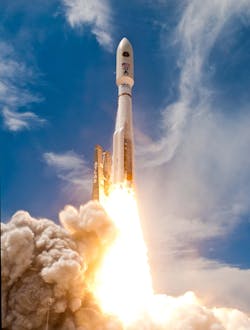WASHINGTON, 8 May 2012. The Boeing Company has completed the second parachute drop test for its Crew Space Transportation (CST) spacecraft. This latest parachute test comes as part of the company’s effort to develop commercial crew transportation capabilities to ferry U.S. astronauts to and from low-Earth orbit (LEO) and the International Space Station (ISS).
During the test, a helicopter lifted the CST-100 crew capsule to roughly 14,000 feet above the Delmar Dry Lake Bed near Alamo, Nev. Staff initiated a drogue parachute deployment sequence, and deployment of the main parachute. The capsule descended to a smooth ground landing that was cushioned by six inflated air bags, demonstrating the performance of the landing system.
"Boeing's parachute demonstrations are a clear sign NASA is moving in the right direction of enabling the American aerospace transportation industry to flourish under this partnership," Ed Mango, NASA's commercial crew program manager, says. "The investments we're making now are enabling this new path forward of getting our crews to LEO and potentially the space station as soon as possible."
Boeing engineers designed the company's CST system to be a reusable, capsule-shaped spacecraft capable of taking up to seven people, or a combination of people and cargo, to and from low-Earth orbit, including the space station. HDT Airborne Systems of Solon, Ohio, designed, fabricated, and integrated the parachute system, including the two drogue parachutes. ILC Dover of Frederica, Del., designed and fabricated the landing air bag system.
The first test, held on 3 April 2012, validated the architecture and deployment of the parachute system, characterized pyrotechnic shock loads, confirmed parachute size and design, and identified potential forward compartment packaging and deployment issues. The company inspected and re-packed the full parachute system for this second test.
"This second parachute drop test validates Boeing's innovative system architecture and deployment plan," says John Mulholland, vice president and program manager of Boeing Commercial Programs. "Boeing's completion of this milestone reaffirms our commitment to provide safe, reliable and affordable crewed access to space."
The company has scheduled additional tests to be performed in 2012 that will provide more data on elements of the spacecraft's design.
The company selected United Launch Alliance's Atlas V rocket for initial CST-100 test flights. Boeing's spacecraft was designed to be compatible with a variety of expendable launch vehicles.
About the Author

Courtney Howard
Executive Editor
Courtney, as executive editor, enjoys writing about all things electronics and avionics in PennWell’s burgeoning Aerospace and Defense Group, which encompasses Military & Aerospace Electronics, Avionics Intelligence, the Avionics Europe conference, and much more. She’s also a self-proclaimed social-media maven, mil-aero nerd, and avid avionics geek. Connect with Courtney at [email protected], @coho on Twitter, and on LinkedIn.
